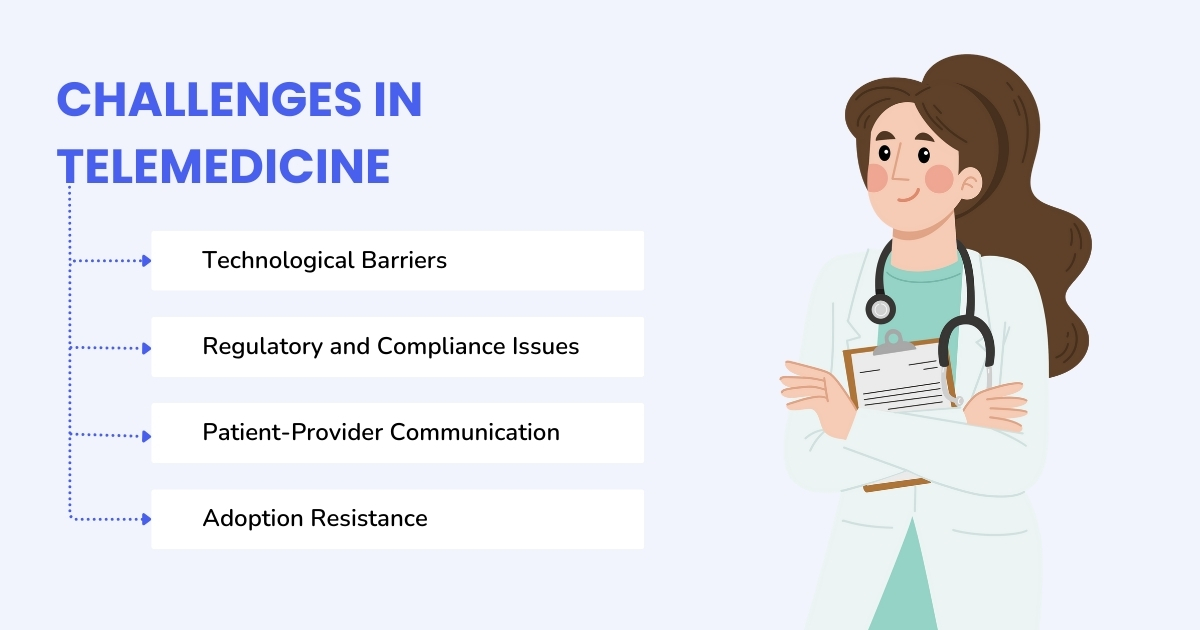Introduction
Overview of Telemedicine’s Growth and Significance
Telemedicine, a groundbreaking innovation in healthcare, has transformed how patients access care and how providers deliver it. Telemedicine has bridged healthcare delivery gaps by enabling virtual consultations, remote monitoring, and reduced hospital visits. However, as promising as it is, this technology faces several barriers.
Brief Mention of Challenges
From inadequate infrastructure to privacy concerns, the challenges in telemedicine are complex yet surmountable. Addressing these hurdles is vital to harness its full potential.
Challenges in Telemedicine
Technological Barriers
1. Access to the Internet and Devices
Reliable internet access and advanced devices are prerequisites for telemedicine. Unfortunately, rural and underserved areas often lack these resources, creating significant disparities in access.
2. Digital Literacy Issues
Even when technology is available, many patients and providers face difficulties using telemedicine platforms effectively. This issue is especially prevalent among older populations and technologically inexperienced users.
Regulatory and Compliance Issues
1. Legal and Privacy Concerns
Healthcare systems worldwide must navigate a maze of laws governing telehealth. These include HIPAA compliance in the US and GDPR in Europe, which demand stringent data security measures. Breaches can lead to severe consequences for providers and patients alike.
2. Licensing Complexities
Physicians often require separate licenses to practice telemedicine across state or national borders. This limits the scalability of telehealth services and adds administrative hurdles.
Patient-Provider Communication
1. Limitations of Virtual Interaction
Without in-person cues, such as body language, diagnosing conditions accurately can be challenging. Miscommunication during doctor and patient virtual consultations may affect patient outcomes.
2. Addressing Language and Cultural Barriers
In multicultural societies, language differences and cultural nuances can impede effective communication, potentially leading to misunderstandings and dissatisfaction.
Adoption Resistance
1. Resistance from Patients or Healthcare Providers
Some patients are skeptical about virtual care due to privacy concerns or lack of trust in its effectiveness. Similarly, healthcare providers may resist telemedicine, citing increased workloads or reduced personal interaction.
Potential Solutions
1. Advancing Infrastructure and Technology
Governments and private organizations must invest in broadband networks and affordable telehealth devices. Partnerships with tech companies can accelerate innovation in white-label telemedicine platforms.
2. Regulatory Reforms and Standardization
Harmonizing telehealth regulations across jurisdictions can ease licensing issues and promote widespread adoption. Creating universal standards for privacy and data security is equally crucial.
3. Enhanced Training for Patients and Providers
Providing user-friendly interfaces and offering training programs can boost digital literacy among patients and practitioners. Simulations and practice sessions for healthcare providers can improve confidence and competency.
4. Focused Communication Strategies
Telemedicine platforms should include multilingual support and culturally sensitive designs to overcome language and cultural barriers. Incorporating AI-based translation tools can further enhance communication.
Conclusion
Summary of Challenges and Solutions
Telemedicine has revolutionized healthcare delivery, but barriers like technological limitations, regulatory complexities, and communication issues remain. Addressing these challenges is key to realizing its full potential.
Importance of Collaboration in Overcoming Barriers
Collaboration between governments, tech innovators, and healthcare providers is vital. Together, they can ensure that telemedicine becomes a universally accessible, secure, and effective healthcare solution.
If there are concerns regarding these challenges, vDoctor platforms present a viable solution. With robust security measures, a user-friendly interface, features, and the ability to scale effectively, vDoctor complies with regulatory requirements while providing healthcare professionals with a dependable tool for remote consultations.
